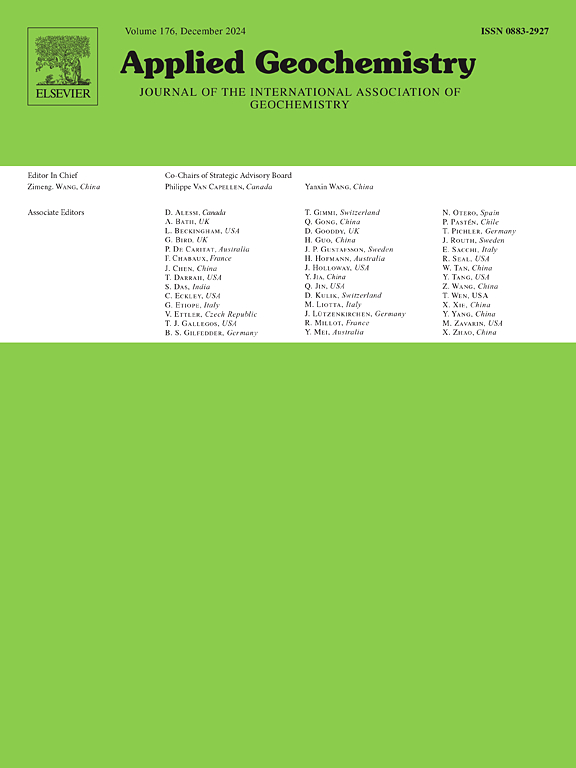Permeate fluxes from desalination of brines and produced waters: A reactive transport modeling study
IF 3.4
3区 地球科学
Q1 GEOCHEMISTRY & GEOPHYSICS
引用次数: 0
Abstract
The increasing interest in the use of membrane systems to desalinate inland brackish water, agricultural drainage, and industrially produced wastewater demands improved means of predicting desalination system performance under variable feedwater compositions. The interaction among water flow, solute transport, and chemical composition in these systems impacts permeate flux evolution. Here, an established multicomponent reactive transport simulator that accounts for these coupled processes is applied to compute osmotic pressure and permeate fluxes in reverse osmosis (RO) systems. The model is first validated by predicting permeate fluxes for a set of benchtop crossflow experiments subject to a range of feed flow rates and compositions, under fouling and non-fouling conditions. Results compare favorably with measured data that show that solutions with similar total dissolved solids concentrations but different compositions result in different permeate fluxes. The model is then applied to predict permeate fluxes from the desalination of produced waters using a commercial spiral wound RO module. For NaCl-dominant brines, at total dissolved salt concentrations (TDS) below about 70 g/L, permeate fluxes are inversely proportional to water mole fraction as the latter is a reasonable approximation of water activity (i.e. ideal mixing). In the case of Ca–Cl-, Na–CO3- and Na–SO4-dominant brines below about 70 g/L TDS, this relationship does not hold as well and tends to overpredict osmotic pressure and thus underpredict permeate fluxes. However, the opposite becomes true at higher TDS values for typical produced waters. The scaling potential of these waters is also computed by allowing the precipitation of minerals above their saturation limit on the RO membrane. This work demonstrates how reactive transport models developed for the analysis of waters from geological systems can be extended to improve process design, optimization, and control in desalination systems from produced waters and beyond.
盐水和采出水脱盐的渗透通量:反应输运模型研究
人们对利用膜系统淡化内陆咸淡水、农业排水和工业废水的兴趣日益浓厚,这就需要改进预测海水淡化系统在不同给水成分下性能的方法。这些系统中水流、溶质输运和化学成分之间的相互作用影响渗透通量演化。本文建立了一个考虑这些耦合过程的多组分反应输运模拟器,用于计算反渗透(RO)系统中的渗透压和渗透通量。首先,通过在一系列进料流量和成分、污垢和非污垢条件下的台式交叉流实验中预测渗透通量来验证该模型。结果与测量数据比较有利,表明具有相似的总溶解固体浓度但不同组成的溶液导致不同的渗透通量。然后将该模型应用于使用商业螺旋缠绕RO模块预测采出水脱盐的渗透通量。对于以nacl为主的盐水,在总溶解盐浓度(TDS)低于约70 g/L时,渗透通量与水摩尔分数成反比,因为后者是水活度的合理近似值(即理想混合)。对于低于70 g/L TDS的Ca-Cl -、Na-CO3 -和na - so4优势盐水,这种关系不成立,并且倾向于高估渗透压,从而低估渗透通量。然而,对于典型的采出水,当TDS值较高时,情况正好相反。这些水的结垢势也可以通过允许在反渗透膜上沉淀超过其饱和极限的矿物质来计算。这项工作证明了为分析地质系统的水而开发的反应输运模型如何可以扩展到改进生产水及其他海水淡化系统的工艺设计、优化和控制。
本文章由计算机程序翻译,如有差异,请以英文原文为准。
求助全文
约1分钟内获得全文
求助全文
来源期刊

Applied Geochemistry
地学-地球化学与地球物理
CiteScore
6.10
自引率
8.80%
发文量
272
审稿时长
65 days
期刊介绍:
Applied Geochemistry is an international journal devoted to publication of original research papers, rapid research communications and selected review papers in geochemistry and urban geochemistry which have some practical application to an aspect of human endeavour, such as the preservation of the environment, health, waste disposal and the search for resources. Papers on applications of inorganic, organic and isotope geochemistry and geochemical processes are therefore welcome provided they meet the main criterion. Spatial and temporal monitoring case studies are only of interest to our international readership if they present new ideas of broad application.
Topics covered include: (1) Environmental geochemistry (including natural and anthropogenic aspects, and protection and remediation strategies); (2) Hydrogeochemistry (surface and groundwater); (3) Medical (urban) geochemistry; (4) The search for energy resources (in particular unconventional oil and gas or emerging metal resources); (5) Energy exploitation (in particular geothermal energy and CCS); (6) Upgrading of energy and mineral resources where there is a direct geochemical application; and (7) Waste disposal, including nuclear waste disposal.
 求助内容:
求助内容: 应助结果提醒方式:
应助结果提醒方式:


